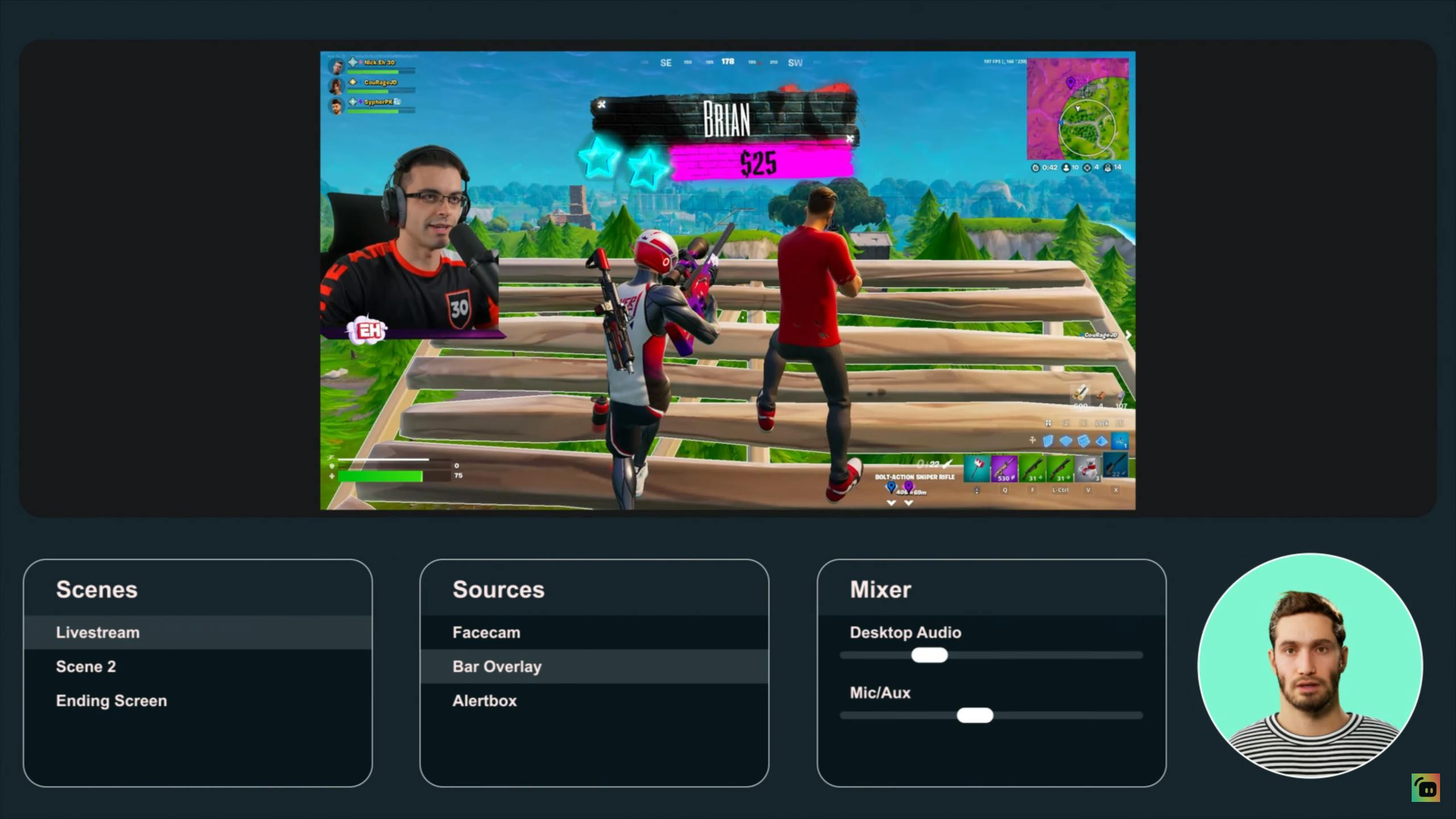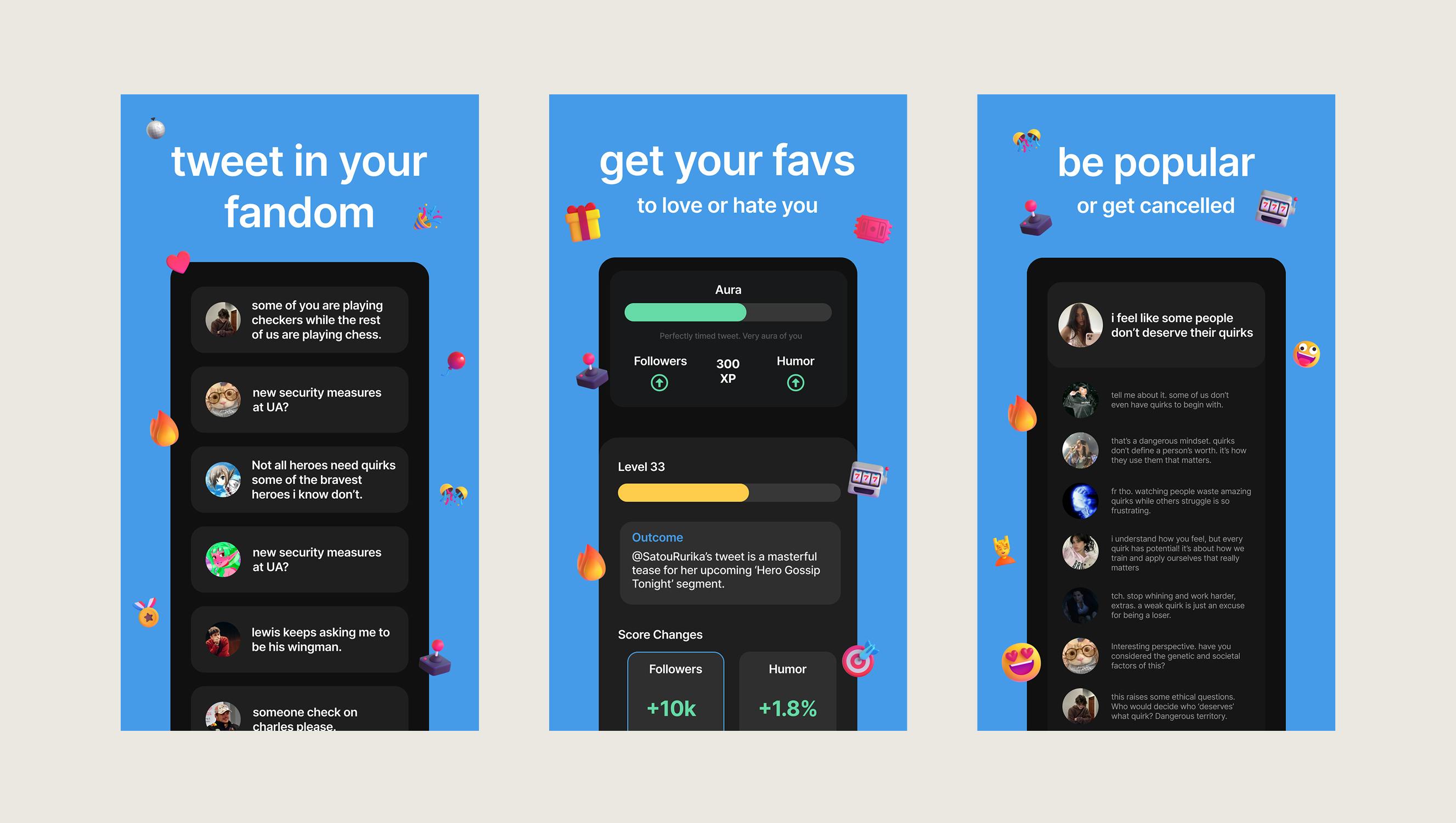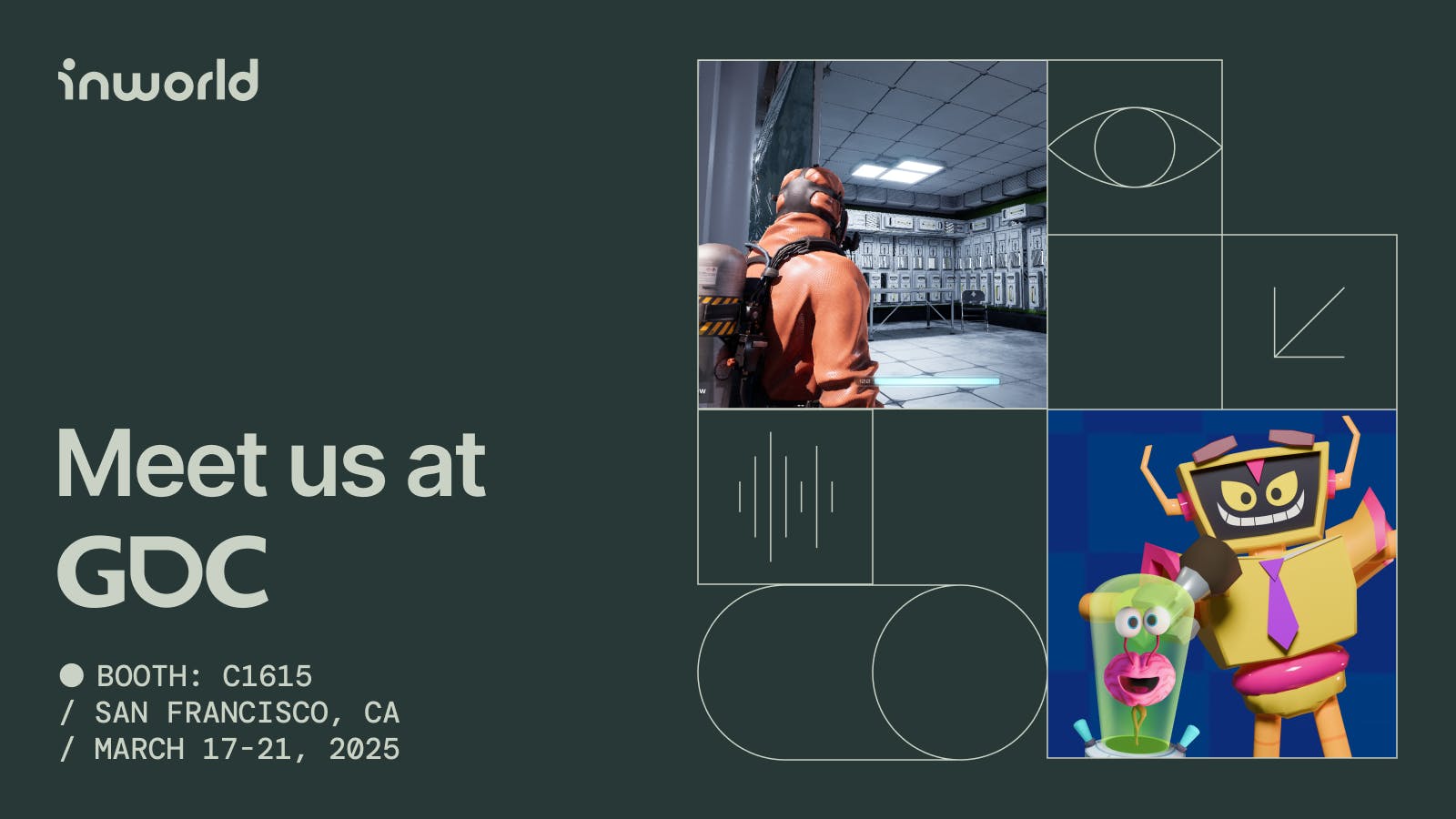Check out what's new:
GDC 2025: Beyond prototypes to production AI–overcoming critical barriers to scale
At the GDC 2025, Inworld isn’t here to talk about the future of AI–we’re showcasing real games using AI at scale, enjoyed by millions of players.
The current AI ecosystem wasn't built with game developers in mind. While impressive in controlled demos, today's AI technologies expose critical limitations when transitioning to production-ready games. Developers are dependent on black-box APIs with unpredictable pricing and shifting terms, leading to a loss of autonomy and stalled innovation. Players are left with disposable "AI-flavored" demos instead of sustained, evolving experiences.
At the Game Developers Conference 2025, Inworld isn’t here to showcase technology for technology's sake. We're demonstrating how developers have overcome these structural barriers to ship AI-powered games that millions of players are enjoying right now. Their experiences highlight why so many AI projects fail before launch and more importantly, how to overcome these challenges.
Summary of partner demos
At GDC, we'll be showcasing several key partner demos that highlight how studios of all sizes are successfully implementing AI:
- Streamlabs: Intelligent Streaming Agent provides real-time commentary and production assistance
- Little Umbrella: The Last Show, a web-based party game with witty AI hosting
- Wishroll: Status, a social media simulation game with unique AI-driven personalities
- Virtuos: Giving developers full control over AI character behaviors for a more immersive storytelling experience
- Nanobit: Winked, a mobile chat game with persistent, evolving relationship building
Additionally, we'll feature two Inworld-developed technology showcases:
- On-device Demo: A cooperative game running seamlessly on-device across multiple hardware platforms
- Realistic Multi-agent Simulation: Multi-agent simulation demonstrating realistic social behaviors and interactions
The critical barriers blocking AI games from production and real developer solutions
Below are seven of the key challenges that consistently prevent AI-powered games from making the leap from promising prototype to shipped product. Here’s how studios of all sizes used Inworld to break through these barriers and deliver experiences enjoyed by millions.
The real-time wall: Streamlabs Intelligent Agent
The developer problem: Non-production ready cloud AI introduces response delays that break player immersion. Unoptimized cloud dependencies result in AI response times of 800-1200ms, making even the simplest interactions feel sluggish. All intelligence remains server-side, creating single points of failure and preventing true ownership, yet most developers can find few alternatives beyond this cloud-API-only AI workflow that locks them into perpetual dependency architectures.
The Inworld solution: The Logitech G’s Streamlabs Intelligent Streaming Agent is an AI-driven co-host, producer, and technical sidekick that observes game events in real time, providing commentary during key moments, assisting with scene transitions, and driving audience engagement—letting creators focus on content without getting bogged down in production tasks.
"We tried building this with standard cloud APIs, but the 1-2 second delay made the assistant feel disconnected from the action," explains the Streamlabs team. "Working with Inworld, we achieved 200ms response times that make the assistant feel present in the moment."

"We tried building this with standard cloud APIs, but the 1-2 second delay made the assistant feel disconnected from the action," explains the Streamlabs team. "Working with Inworld, we achieved 200ms response times that make the assistant feel present in the moment."
Behind the scenes, the Inworld Framework orchestrates the assistant's multimodal input processing, contextual reasoning, and adaptive output. By integrating seamlessly with third-party models and the Streamlabs API, Inworld makes it easy to interpret gameplay, chat, and voice commands, then deliver real-time actions—like switching scenes or clipping highlights. This approach saves developers from writing custom pipelines for every new AI model or event trigger.
This isn't just faster—it's the difference between an assistant that feels alive versus one that always seems a step behind the action.
The success tax: The Last Show
The developer problem: Success should be a cause for celebration, not a financial crisis. Yet, for AI-powered games, linear or even increasing unit costs mean expenses can quickly spiral out of control as user numbers grow. Instead of scaling smoothly, developers are forced to make emergency architecture changes, when they should be doubling down on success.
The Inworld solution: Little Umbrella, the studio behind Death by AI, was no exception. While the game was an instant hit–reaching 20 million players in just two months – the success nearly bankrupted the studio. "Our cloud API costs went from $5K to $250K in two weeks," shares their technical director. "We had to throttle user acquisition—literally turning away players—until we partnered with Inworld to restructure our AI architecture."
For their next game, they decided to flip the script, building with cost predictability and scalability in mind from day one. Introducing The Last Show, a web-based party game where an AI host generates hilarious questions based on topics chosen or customized by players. Players submit answers, vote for their favorites, and the least popular response leads to elimination – all while the AI host delivers witty roasts.
The Last Show marks their comeback, engineered from the ground up to maintain both quality and cost predictability at scale. The result? A business model that thrives from success rather than being threatened by it.
The quality-cost paradox: Status
The developer problem: Better AI quality often correlates with higher costs, forcing developers into an impossible decision: deliver a subpar player experience or face unsustainable costs. AI should enhance gameplay, not become an economic roadblock.
The Inworld solution: Wishroll's Status (ranking as high as #4 in the App Store Lifestyle category) immerses players in a fictional world where they can roleplay as anyone they imagine—whether a world-famous pop star, a fictional character, or even a personified ChatGPT. Their goal is to amass followers, develop relationships with other celebrities, and complete unique milestones.

The concept struck a chord with gamers and by the time the limited access beta launched in October 2024, Status had taken off. TikTok buzz drove over 100,000 downloads with many gamers getting turned away, while the game's Discord community ballooned from a modest 100 users to 60,000 within a few days. Only two weeks after their public beta launch in February 2025, Status surpassed one million users.
"We were spending $12-15 per daily active user with top-tier models," says CEO Fai Nur. "That's completely unsustainable. But when we tried cheaper alternatives, our users immediately noticed the quality drop and engagement plummeted."
Working with Inworld's ML Optimization services, Wishroll was able to cut AI costs by 90% while improving quality metrics. "We saw how Inworld solved similar problems for other AI games and thought, 'This is exactly what we need,'" explained Fai. "We could tell Inworld had a lot of experience and knowledge on exactly what our problem was – which was optimizing models and reducing costs."
"If we had launched with our original architecture, we'd be broke in days," Fai explains. "Even raising tens of millions wouldn't have sustained us beyond a month. Now we have a path to profitability."
The agent control problem: Partnership with Virtuos
The developer problem: Even with sustainable performance benchmarks met, complex narrative games still require sophisticated control over AI agents' behaviors, memories, and personalities to deliver deeply immersive and engaging experiences to gamers. Traditional approaches either lead to unpredictable interactions or require prohibitively complex scripting, making it nearly impossible to create believable characters with consistent personalities.
The Inworld solution: Inworld is partnering with Virtuos, a global game development powerhouse known for co-developing some of the biggest AAA titles in the industry like Marvel’s Midnight Suns and Metal Gear Solid Delta: Snake Eater. With deep expertise in world-building and character development, Virtuos immediately saw the need for providing developers with precise control over the personalities, behaviors, and memories of AI-driven NPCs. This ensures storytelling consistency and players’ choices to dynamically influence the narrative's direction and outcome.
Inworld’s suite of generative AI tools provides the cognitive core that brings these characters to life while equipping developers with full customization capabilities. Teams can fine-tune AI-driven characters to stay true to their narrative arcs, ensuring they evolve logically and consistently within the game world. With Inworld’s tools, Virtuos can focus on what they do best–creating rich, immersive experiences.
"At Virtuos, we see AI as a way to enhance the artistry of game developers and accurately bring their visions to life," shares Piotr Chrzanowski, Chief Technology Officer. “By integrating AI, we enable developers to add new dimensions to their creations, enriching the gaming experience without compromising quality. Our partnership with Inworld opens the door to gameplay experiences that weren’t possible before.”
The immersive dialogue challenge: Winked
The developer problem: Nanobit’s Winked is a mobile interactive narrative experience where players build relationships through dynamic, evolving conversations, including direct messages with core characters. To meet player expectations, the player-facing AI-driven dialogue had to exceed what was possible even with frontier models — offering more personal, emotionally nuanced, and stylistically unique interactions. Yet, achieving the level of quality was beyond the capabilities of off-the-shelf models, and the high costs of premium AI solutions made scalability a challenge.
The Inworld solution: Using Inworld Cloud, Nanobit trained and distilled a custom AI model tailored specifically for Winked. This model delivered superior dialogue quality–more organic, personal, and contextually aware than off-the-shelf solutions—while keeping costs a fraction of traditional cloud APIs. The AI integrated seamlessly into Winked’s core game loops, enhancing user engagement while maintaining financial viability.
Beyond improving player immersion, this AI-driven dialogue system remembers past conversations and carries the storyline forward, providing the player with relationships that evolve as chats progress. This in turn encourages players to engage in longer conversations and return more frequently as they grow closer to characters.
The hardware fragmentation challenge: On-device Demo
The developer problem: AI features optimized for high-end devices fail on mainstream hardware, forcing developers to either limit their audience or compromise their vision. AI vendors also obscure critical capabilities required for on-device inference (distilled models, deep fine-tuning and distillation, runtime model adaptation) to maintain control and protect recurring revenue.
The Inworld solution: While on-device is the key to a more scalable future of AI and games, AI hardware in gaming doesn't have a one-size-fits-all solution. Ensuring consistent performance and accessibility for users on various devices can easily drive up complexity and cost. To achieve scalability, AI solutions must adapt seamlessly across diverse hardware configurations.
Our on-device demo showcases an AI-powered cooperative gameplay running seamlessly across three hardware configurations:
- NVIDIA GeForce RTX™ 5090
- AMD Radeon™ RX 7900 XTX
- Tenstorrent QuietBox
This demo isn't about theoretical compatibility; it's about achieving consistent performance across diverse hardware, allowing developers to target the full spectrum of gaming devices without sacrificing quality.
The multi-agent orchestration challenge: Realistic multi-agent simulation
The developer problem: Creating living, believable worlds requires coordinating multiple AI agents to interact naturally with each other and the player. Developers struggle to create social dynamics that feel organic rather than mechanical, especially at scale.
The Inworld solution: Our Realistic Multi-agent Simulation demonstrates how to effectively orchestrate multiple AI agents into cohesive, living worlds using Inworld. By implementing sophisticated agent coordination systems, contextual awareness, and shared environmental knowledge, this simulation creates believable social dynamics that emerge naturally rather than through scripted behaviors.
Whether forming spontaneous crowds around exciting in-game events, reacting to shared group emotes, or engaging in multi-character conversations, these autonomous agents showcase how proper agent orchestration enables emergent, lifelike behaviors at scale. This technical demonstration underscores the potential for deep player immersion and sustained engagement by bringing social hubs to life—where multiple characters interact with consistent personalities, mutual awareness, and collective response patterns that create the feeling of a truly living world.
The development difference: Going beyond prototypes
The gap between prototype and production is where most AI game projects collapse. While out-of-the-box plugins are useful for prototyping, they break under real-world conditions:
- Latency collapse: Cloud-dependent tools see response times balloon under load, breaking immersion and even gameplay
- Cost explosion: Per-token pricing creates financial cliff edges that make scaling unpredictable
- Reliability bottlenecks: Each external API call introduces a new potential point of failure
- Quality consistency: AI performance varies dramatically between test and production environments
"We've watched incredible AI game prototypes die in the transition to production for four years now," says Evgenii Shingarev, VP of Engineering at Inworld. "The pattern is always the same: impressive demo, enthusiastic investment, then the slow realization that the economics and technical architecture don't support real-world deployment."
At Inworld, we've worked relentlessly to close this prototype-to-production gap, developing solutions that address the real-world challenges of shipping and scaling AI-powered games—not just showcasing impressive demos. At GDC, we're excited to share experiences that don't just make it to launch, but thrive at scale.
Connect with us live at GDC
Visit us at booth C1615: Real problems, real solutions
Visit us in the GDC expo to see these projects firsthand and speak with developers who have tackled the structural challenges of deploying AI in games at scale.
We've got a jam-packed week ahead of us and will be showcasing all of these projects at our GDC booth and in sessions. Instead of talking about the future of gaming with AI, we’ll show the real systems solving real problems, developed by teams who have faced the same challenges you're encountering.
The path from AI prototype to production is challenging, but with the right approach and partners who understand what it takes to ship AI experiences that players love, it's absolutely achievable.

Session with Little Umbrella & Wishroll: Scaling AI-powered games—breaking barriers in cost, latency, and performance.
Scalability is one of the biggest challenges developers face when integrating AI into games. While off-the-shelf AI plugins work well for prototyping, they often fail to scale—hindered by latency, cost, and reliability issues.
Yet, some studios have cracked the code.
- Little Umbrella’s Death by AI reached 20 million players in just three months
- Wishroll’s Status hit one million users within two weeks of their beta launch
Join Tabish Ahmed (CEO, Little Umbrella) and Fai Nur (CEO, Wishroll) to learn how they scaled AI-powered games to millions while maintaining low latency, high quality, and profitability—by lowering their AI costs by 95%.
Kylan Gibbs (CEO, Inworld AI) will further explore the scalable future of AI with on-device inference. AI hardware isn’t one-size-fits-all, and ensuring consistent performance across hardware is key to both accessibility and cost efficiency.
As Jim Keller, a legendary hardware engineer and CEO of Tenstorrent, explains: “Current AI infrastructure is economically unsustainable for games at scale. We're seeing studios adopt impressive AI features in development, only to strip them back before launch once they calculate the true cloud costs at scale."
To enable developers to reach more players without sacrificing quality or spending countless hours optimizing for different hardware, Inworld ensures AI gameplay to run seamlessly across diverse hardware.
Session details:
- Thursday, 3/20, 9:30AM - 10:30AM
- West Hall, Room #2000
- For more details, visit the GDC page
Session with Microsoft: AI innovation for game experiences
Join Microsoft's Haiyan Zhang and Katja Hofmann with Inworld CEO Kylan Gibbs to explore how AI can drive the next wave of dynamic game experiences. This panel bridges research and practical implementation, addressing the critical challenges developers face when moving from prototypes to production.
The session showcases how our collaborative approach solves industry-wide barriers preventing AI games from reaching players – focusing on proven patterns that overcome the reliability, quality, and cost challenges most games never survive.
Session details:
- Monday, 3/17, 10:50AM - 11:50AM
- West Hall, Room #3011
- For more details, visit the GDC page